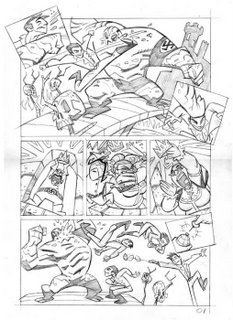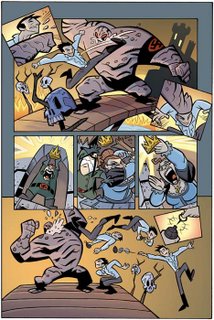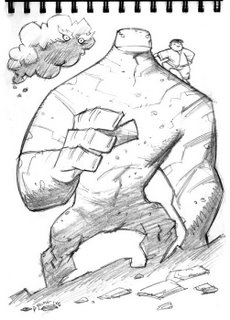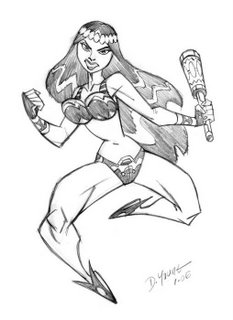For those interested, I'd like to briefly show the steps taken in completing a comic book page for
Gun Fu: Showgirls Are Forever (Image Comics, March 2006.... shameless plug #1).
Step One:Howard Shum (along with Dave Sim) writes the script. The script is very similar to a screenplay, but each shot is an individual panel. Descriptions of what goes into each panel are given, along with character dialogue that needs to fit into the panel.
Step Two:I get the script, read it over a few times, and start to visualize things. I make a list of characters and reference items needed for the story. Are they existing characters (which I can use past comics for reference), or are they new characters (which I'll need to design)? The list of reference items may include anything from a hand gun to a World War 2 bomber. A trip to the library and Google image searches are soon underway.
Step Three: Thumbnail the whole script out in little 2" x 1" sketches. These are decipherable by nobody else but me, but an essential first step in transforming the written word to the drawn image. Page layouts really begin at this point. (Unfortunately, I tossed the thumbnails out...aarrgh)
Step Four:Do a rough layout of the page and send it to Howard for his thoughts. I like to do these on 8 1/2" x 11" paper, with the drawing being the printed comic size, 6" x 9".

Step Five:
Blow up roughs on xerox machine to original comic art size (about 11" x 17"). Trace off, and use as refer for final penciled page.
 Step Six:
Step Six:Fed Ex batches of penciled pages to Howard for inking.

Step Seven:
Howard e-mails high resolution files to Etienne Simon for coloring.
 Step Eight:
Step Eight:Etienne e-mails high resolution colored files back to Howard for lettering (in process as we speak).
Final Steps:Completed book is sent to printer.
Printer sends book to Distributor.
Distributor sends book to Comic Shop.
Hopefully you will buy it from Comic Shop (Image Comics, March 2006... shameless plug #2)
;)



 Step Six:
Step Six:

